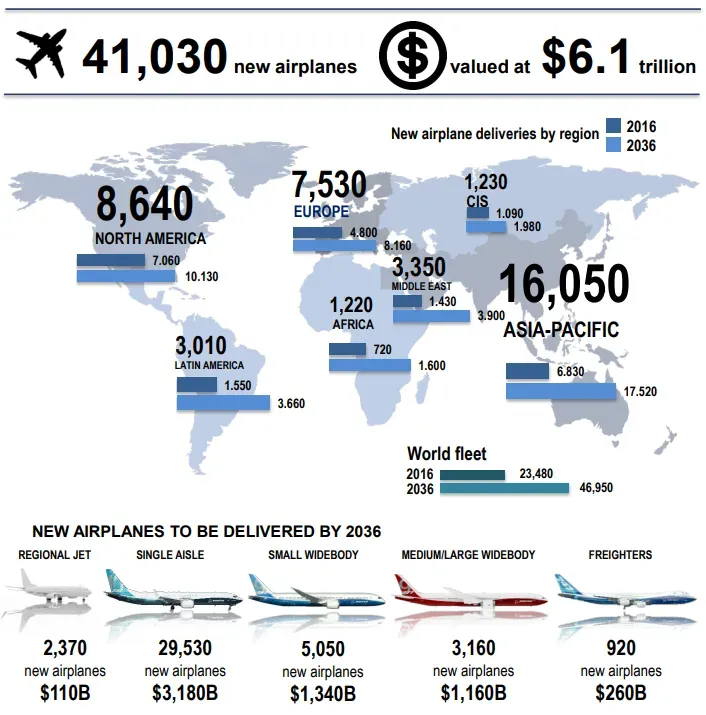Aerospace tariffs impact the U.S. aerospace sector significantly, with industry giants like RTX and GE Aerospace projecting combined losses exceeding $1 billion due to new import duties. RTX anticipates an $850 million hit from the tariffs introduced by President Trump, affecting their production costs and pricing strategies. GE, on the other hand, forecasts a $500 million impact, leading to adjustments in their operational plans to counter these financial pressures. The increasing tariffs on imported goods and materials not only threaten profit margins but also highlight the vulnerability of the global supply chain that underpins aerospace manufacturing. With a history of favorable trade conditions, this shift poses critical challenges for manufacturers like RTX and GE as they navigate these turbulent economic waters.
The repercussions of recent trade duties within the aerospace industry have raised significant concerns among leading manufacturers. Companies such as RTX and GE Aerospace are reevaluating their financial forecasts in light of increased tariffs on imported components, which are vital for aircraft production. This disruptive climate, characterized by heightened tariffs from the U.S. government, jeopardizes the stability of the global supply chains upon which the aerospace sector relies. As these companies brace for substantial economic impacts, they must also adapt their strategies to maintain profitability and competitiveness in an ever-evolving market landscape. Industry stakeholders are calling for a reassessment of current trade policies to better support the U.S. aerospace sector amid these challenges.
Impact of Aerospace Tariffs on RTX and GE Aerospace
Aerospace tariffs have recently become a significant concern for major manufacturers like RTX and GE Aerospace, leading to an anticipated collective financial impact exceeding $1 billion. RTX, a giant in the aerospace industry, predicts that it will suffer an $850 million hit this fiscal year due to these tariffs. This figure is a direct consequence of the 10% duties imposed by the Trump administration, which also includes heightened tariffs for nations like China, as well as increased fees on imported materials such as steel and aluminum. These financial burdens challenge RTX and others in the sector, pushing them to consider various mitigation strategies while navigating turbulent economic conditions.
Similarly, GE Aerospace is bracing for around $500 million in tariff-related impacts. CEO Larry Culp, during discussions with President Trump, highlighted the importance of understanding the dynamics of the U.S. aerospace sector within the broader context of global supply chain dependencies. These tariffs mark a drastic policy shift for an industry that had previously enjoyed decades of duty-free trade, stirring concerns about rising costs and potential disruptions to production. The long-standing trade practices that have supported the U.S. aerospace sector’s growth are now at risk, making tariff effects on manufacturers a critical point of discussion among industry leaders.
The U.S. Aerospace Sector: Navigating Tariff Challenges
The U.S. aerospace sector, encompassing a wide range of companies engaged in manufacturing engines, airplanes, and other aerospace products, now faces unprecedented tariff challenges. With tariffs being a new variable in their operating environment, companies are forced to reassess their pricing strategies as they aim to maintain their market positions. For instance, both RTX and GE Aerospace have already indicated that they plan to implement cost-saving measures and possibly raise prices to offset the tariff impacts. This strategic pivot is essential to safeguard profitability amidst rising operational costs.
Moreover, tariffs could potentially alter the competitive landscape in the United States and globally. The aerospace industry is tightly woven into a global supply chain, and disruptions caused by tariffs could lead to increased prices for consumers and reduced sales for manufacturers. As highlighted by CEO Larry Culp, there is a fundamental need for the government to reconsider the tariffs’ wider implications on the U.S. aerospace sector, particularly in terms of maintaining a favorable trade environment that has historically benefitted the industry. The task for industry leaders now is to devise robust strategies that can withstand these uncertain tariff conditions.
Global Supply Chain Tariffs and Their Effects
Global supply chain tariffs have emerged as a pressing issue for manufacturers across various sectors, but for the aerospace industry, the stakes are particularly high. Companies like RTX and GE Aerospace heavily rely on international suppliers for components and materials necessary for aircraft production. The imposition of significant tariffs on imports not only increases costs for these manufacturers but also jeopardizes their competitive standing in the global market. As costs escalate, companies must adapt swiftly, exploring new sourcing options, renegotiating supplier contracts, or even relocating supply chain operations to mitigate the tariff impacts.
Furthermore, the ripple effects of these tariffs extend beyond mere cost adjustments. There are potential ramifications for employment and investment decisions within the aerospace sector as businesses brace for a tighter financial landscape. If tariffs remain in place or escalate, the industry may face tough decisions, including layoffs or delaying capital investments. Executives, including those at major firms like Boeing, are now faced with the challenge of navigating this newfound uncertainty while managing stakeholder expectations against a backdrop of fluctuating demand and changing trade policies.
Tariff Effects on Manufacturers: Risks and Opportunities
The tariff effects on manufacturers are multifaceted, presenting both risks and potential opportunities for companies within the aerospace sector. While tariffs raise the cost of imported goods, which can squeeze profit margins, they also create an opportunity for domestic manufacturers to capture a larger share of the market. With foreign products becoming more expensive, local industries can potentially expand their offerings and increase production to meet domestic demand. Companies like RTX and GE Aerospace can leverage these conditions to strengthen their foothold in the market, although doing so requires strategic planning and flexibility.
Moreover, the economic landscape following the implementation of tariffs creates a unique environment for innovation and investment in new technologies or processes. Manufacturers, in their effort to counteract rising costs, may explore automation or alternative materials that can help drive efficiency and reduce dependency on imported goods. As stated by RTX’s CFO Neil Mitchill, even with the anticipated financial blow, the company must explore innovative solutions to mitigate these impacts, suggesting that the aerospace industry could enter a phase of transformation driven by necessity and competition.
Future Outlook for the U.S. Aerospace Industry
Looking ahead, the future of the U.S. aerospace industry is fraught with uncertainty stemming from ongoing tariff implications and shifts in consumer demand. Major players like RTX and GE Aerospace will need to navigate these complexities while striving to maintain their competitive edge in the global marketplace. The landscape is changing rapidly, with executives like Larry Culp emphasizing the need for a strategic response to these external pressures while preserving operational integrity. This could involve diversification of supply chains and enhanced domestic production capabilities to counterbalance the costs incurred by tariffs.
Additionally, as the industry adapts to this new reality, there may be opportunities for collaboration among aerospace manufacturers to advocate for favorable trade policies. The establishment of dialogue between corporations and government officials could help shape a more conducive regulatory framework that promotes growth rather than constraining it through heavy tariffs. The road ahead may be challenging, but with a proactive stance and a willingness to innovate, the U.S. aerospace sector can potentially navigate through these turbulent waters and emerge stronger.
Larry Culp’s Perspective on Tariffs and Trade
Larry Culp, the influential CEO of GE Aerospace, has vocalized the potential adverse outcomes of the recently imposed tariffs on the aerospace sector. His recent discussions with President Trump underscore his commitment to addressing the concerns faced by manufacturers in navigating these turbulent financial waters. Culp emphasized the historical strength of the industry under a tariff-free environment, suggesting that a reconsideration of trade policies could benefit all stakeholders involved, from manufacturers to consumers. His insights reflect a critical viewpoint, advocating for collaborative approaches that could stabilize and strengthen the U.S. aerospace industry.
Culp’s stance carries weight as leaders in the aerospace sector grapple with rising costs due to tariffs on materials and imported goods. By urging the administration to revisit these tariffs, he is not just protecting GE Aerospace’s interests, but also highlighting the need for a robust and resilient aerospace sector. His proactive discussions with policymakers aim to foster understanding and, ideally, legislative adjustments that can alleviate tariff burdens, allowing companies like GE to sustain their growth and innovation in a highly competitive global landscape.
Adapting to Soaring Tariffs in the Aerospace Sector
In an environment where tariffs are rising, aerospace companies must adapt swiftly to protect their market positions and profitability. Both RTX and GE Aerospace are implementing various strategies to cope with the realities of soaring tariffs, such as increasing prices and cutting costs in their operations. This pivot towards strategic adaptation not only illustrates the companies’ resilience but also their foresight in anticipating future challenges. Manufacturers are now called to reassess their supply chain dynamics and pricing models in light of escalating operational costs brought about by tariffs.
Furthermore, these adaptations may also extend to innovation, pushing manufacturers to invest in new technologies that optimize production efficiency and sourcing practices. As companies like RTX aim to mitigate the financial impact, exploring alternatives to imported materials or enhancing supply chain logistics could present opportunities for improving their overall competitiveness. Moreover, embracing innovation during this transitional period could yield long-term benefits, allowing aerospace firms to establish a more robust foothold against tariff repercussions in the ever-evolving global market.
President Trump’s Tariffs: A Historic Shift in Aerospace Trade
The implementation of President Trump’s tariffs marks a historic shift in the landscape of aerospace trade, affecting companies that have thrived under tariff-free regulations for decades. For aerospace giants like RTX and GE Aerospace, these tariffs introduce significant challenges with estimations of over $1 billion in combined impacts. This scenario not only transforms how these companies operate but also prompts a broader reconsideration of their strategies to maintain competitiveness and profitability amid rising costs.
This landmark change aims to realign trade dynamics, compelling U.S. manufacturers to reconsider their dependence on global supply chains and foreign imports. As the industry grapples with the implications of such abrupt policy changes, it also sheds light on the need for a cohesive strategy that protects the interests of American manufacturers while fostering a favorable trade climate. Navigating this shift will require foresight, adaptation, and a strategic approach to mitigate the risks posed by tariffs while leveraging any potential advantages.
The Role of Boeing in the Aerospace Tariff Conversation
Boeing, as a primary customer for both RTX and GE Aerospace, plays a crucial role in the broader conversation about aerospace tariffs and their impacts on the industry. As one of the leading U.S. exporters, Boeing’s performance is intrinsically linked to how manufacturers adjust to the new tariff landscape. The aerospace giant’s strategies for managing increased costs and mitigating tariff risks will be closely watched by industry stakeholders, as they could set the tone for how the sector evolves in response to these challenges.
Moreover, Boeing’s quarterly results will provide valuable insights into the current health of the aerospace market and the effects of tariffs on manufacturers’ bottom lines. If Boeing announces strong results despite tariff pressures, it could signal resilience in the industry and suggest effective risk mitigation strategies at play. Conversely, any negative reports might underscore the challenges posed by rising tariffs, prompting further scrutiny of U.S. trade policies and their long-term sustainability within the aerospace sector.
Frequently Asked Questions
What is the anticipated impact of RTX tariffs on the aerospace sector?
RTX anticipates an $850 million impact from aerospace tariffs, significantly affecting its operations and highlighting the financial strain imposed by recent tariff measures on imported goods and materials.
How will GE Aerospace tariffs affect the company’s financial outlook?
GE Aerospace projects a $500 million impact due to tariffs, but the company aims to mitigate this through cost reductions and price increases, maintaining its earnings outlook for 2025 despite the challenges posed by global supply chain tariffs.
What are the broader tariff effects on manufacturers in the US aerospace sector?
The tariffs, including a broad 10% levy, are expected to cause a combined loss of over $1 billion for RTX and GE Aerospace, reflecting a significant shift in cost structures for US manufacturers reliant on a global supply chain.
What measures are aerospace companies taking to cope with the impact of tariffs?
Aerospace companies like RTX and GE Aerospace plan to implement cost-cutting strategies and price increases to offset the financial burden resulting from tariff effects, particularly as they navigate the new duty environment.
How is the global supply chain affected by recent aerospace tariffs?
Recent tariffs disrupt the global supply chain essential for the aerospace sector, increasing production costs and presenting challenges for manufacturers like RTX and GE Aerospace who rely on international trade for components and materials.
What concerns do aerospace executives have regarding future tariff policies?
Aerospace executives, including GE’s Larry Culp, express concerns about the uncertainty of future tariff policies and their potential impact on the industry’s trade surplus and overall economic trajectory.
How do tariffs influence the earnings outlook for companies like Boeing?
As a leading exporter and primary customer for RTX and GE Aerospace, Boeing’s earnings may be influenced by the rising costs associated with tariffs, which could affect its pricing strategies and production plans.
What is the significance of the tariffs in the context of the aerospace industry’s historical trade practices?
The introduction of tariffs marks a significant departure from decades of tariff-free trade for the aerospace industry, raising concerns among companies about the sustainability of their profit margins and operational strategies moving forward.
| Company | Estimated Tariff Impact (in millions) | Tariff Type | CEO Comments | Future Outlook |
|---|---|---|---|---|
| RTX | $850 | 10% duties, increased duties on China, taxes on steel and aluminum | CFO Neil Mitchill mentioned the impact during an earnings call. | Will face an $850 million impact this year; looks to mitigate effects. |
Summary
The aerospace tariffs impact is significant, with major players like RTX and GE Aerospace estimating a combined loss of over $1 billion due to new tariffs implemented by the Trump administration. As these companies adjust to a changing trade environment characterized by diminished duty-free benefits, they must strategically manage costs and anticipate future regulatory landscapes. The aerospace sector, crucial to the U.S. economic framework, faces uncertainties, particularly with demand fluctuations and evolving trade policies influencing their bottom lines.



